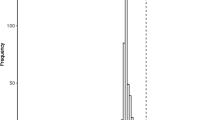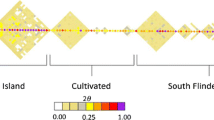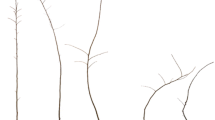Abstract
The estimation of quantitative genetic parameters in breeding programs is important to ensure efficient selection. In this context, knowledge of the mating system is critical, as it underpins assumptions about inter-relatedness on which variance component estimation depends. However, proper account of the breeding system is not always taken, either because it is unknown and/or because it is ignored. That eucalypts have a mixed-mating system is well-established, however many breeders use models that assume outcrossed mating with an infinite number of male parents (i.e. allogamous mating), from which genetic parameter estimates are then used to predict genetic gains. First-generation, open-pollinated progeny tests of Corymbia citriodora subsp. citriodora and C. citriodora subsp. variegata, being managed for seed production, were used to investigate the likely bias, resulting in overestimation of genetic parameters under the assumption of allogamous mating. When we assumed allogamous mating, we observed inflated predictions of additive variance and narrow-sense heritability (\(\hat{h}_{a}^{2}\)) of diameter at breast height and height. The overestimate of \(\hat{h}_{a}^{2}\) was approximately 32% for C. citriodora subsp. citriodora and 21% for C. citriodora subsp. variegata. Inappropriate modelling of relatedness in eucalypts that assumes panmictic outcrossing when in fact these species have a mixed-mating system results in overestimates of the population genetic gain with selection.
Similar content being viewed by others
References
Apiolaza L, McConnochie R, Millen P, Van Ballekom S, Walker J (2011) Introducing durable species to New Zealand drylands: genetics of early adaptation of Eucalyptus bosistoana. In: Walker J (ed) Developing a eucalypt resource: learning from Australia and elsewhere. University of Canterbury, Christchurch, pp 137–146
Bacles CFE, Brooks J, Lee DJ, Schenk PM, Lowe AJ, Kremer A (2009) Reproductive biology of Corymbia citriodora subsp. variegata and effective pollination across its native range in Queensland, Australia. South For 71(2):125–132
Bernardo R (2010) Breeding for quantitative traits in plants. Stemma Press, Woodbury
Berti CLF, Freitas MLM, Zanatto ACS, Morais E, Moraes MLT, Sebbenn AM (2011) Variação genética, herdabilidades e ganhos na seleção para caracteres de crescimento e forma em teste de progênies de polinização aberta de Eucalyptus cloeziana. Rev Inst Flor 23(1):13–26
Brawner JT, Lee DJ, Hardner CM, Dieters MJ (2011) Relationships between early growth and Quambalaria shoot blight tolerance in Corymbia citriodora progeny trials established in Queensland, Australia. Tree Genet Genomes 7:759–772
Brawner JT, Meder R, Dieters M, Lee DJ (2012) Selection of Corymbia citriodora for pulp productivity. South For 74:121–131
Bush D, Thumma B (2013) Characterising a Eucalyptus cladocalyx breeding population using SNP markers. Tree Genet Genomes 9:741–752
Bush D, Kain D, Matheson C, Kanowski P (2011) Marker-based adjustment of additive relationship matrix for estimation of genetic parameters—an example using Eucalyptus cladocalyx. Tree Genet Genomes. 7(1):23–35
Bush D, Kain D, Kanowski PJ, Matheson AC (2015) Genetic parameter estimates informed by a marker-based pedigree: a case study with Eucalyptus cladocalyx in southern Australia. Tree Genet Genomes 11:798
Cane-Retamales C, Mora F, Vargas-Reeve F, Perret S, Contreras-Soto R (2011) Bayesian threshold analysis of breeding values, genetic correlation and heritability of flowering intensity in Eucalyptus cladocalyx under arid conditions. Euphytica 178:177–183
Cappa EP, Klápště J, Garcia MN, Villalba PV, Marcucci Poltri SN (2016) SSRs, SNPs and DArTs comparison on estimation of relatedness and genetic parameters’ precision from a small half-sib sample population of Eucalyptus grandis. Mol Breed 36:97
CEPAGRI (2018) Clima dos municípios paulistas – Itatinga [Internet]. Centro De Pesquisas Meteorológicas E Climáticas Aplicadas à Agricultura. http://www.cpa.unicamp.br/outras-informacoes/clima_muni_271.html. Accessed 18 Jan 2018
Cockerham CC, Weir BS (1984) Covariances o relatives stemming from a population undergoing mixed self and random mating. Biometrics 40:157–164
Costa e Silva J, Hardner C, Tilyard P, Pires AM, Potts BM (2010) Effects of inbreeding on population mean performance and observational variances in Eucalyptus globulus. Ann For Sci 67:605
Costa RB, Marínez DT, Silva JC, Almeida BC (2015) Variabilidade e ganhos genéticos com diferentes métodos de seleção em progênies de Eucalyptus camaldulensis. Rev Cien Agra 58(1):69–74
Denis M, Favreau B, Ueno S, Camus-Kulandaivelu L, Chaix G, Gion JM, Nourrisier-Mountou S, Polidori J, Bouvet JM (2013) Genetic variation of wood chemical traits and association with underlying genes in Eucalyptus urophylla. Tree Genet Genomes 9:927–942
Dianese JC, Haridasan M, Moraes TSA (1986) Screening Eucalyptus species for rust resistance in Bahia, Brazil. Trop Pest Manag 32:292–295
Doerksen TK, Herbinger CM (2010) Impact of reconstructed pedigrees on progeny-test breeding values in red spruce. Tree Genet Genomes 6:591–600
Eldridge K, Davidson J, Harwood C, van Wyk G (1993) Eucalypt domestication and breeding. Claredon Press, Oxford
Falconer DS, Mackay TFC (1996) Introduction to quantitative genetics. Pearson Prentice Hall, Suffolk
Fuchs MCP, Tambarussi EV, Lurenção JC, Nogueira LM, Bortoloto TM, Gonzalez ER, Oda S, Marino CL (2015) Molecular marker associated with a deleterious recessive anomaly in Eucalyptus grandis seedlings. Ann For Sci 72:1043–1052
Gardner RAW, Little KM, Arbuthnot A (2007) Wood and fibre productivity potential of promising new eucalypt species for coastal Zululand, South Africa. Aust For 70(1):37–47
Gilmour AR, Gogel BJ, Cullis BR, Thompson R (2009) ASReml user guide: release 3. VSN International Ltd, Hemel Hempstead
Goodwillie C, Kalisz S, Eckert CG (2005) The evolutionary enigma of mixed mating systems in plants: occurrence, theoretical explanations, and empirical evidence. Annu Rev Ecol Evol Syst 36:47–79
Griffin AR, Cotterill PP (1988) Genetic variation in growth of outcrossed, selfed and open-pollinated progenies of Eucalyptus regnans and some implications for breeding strategy. Silvae Genet 37:124–131
Hardner CM, Potts BM (1997) Postdispersal selection following mixed mating in Eucalyptus regnans. Evolution 51:103–111
Harwood C (2011) New introductions - doing it right. In: Walker J (ed) Developing a eucalypt resource: learning from Australia and elsewhere. Wood Technology Research Centre, University of Canterbury, Christchurch
Henson M, Smith HJ, Boyton S (2008) Eucalyptus longirostrata: a potential species for Australia’s tougher sites? New Zeal J For Sci 38(1):227–238
Hodge GR, Volker PW, Potts BM, Owen JV (1996) A comparison of genetic information from open-pollinated and control-pollinated progeny tests in two eucalypt species. Theor Appl Genet 92:53–63
House APN, Bell JC (1996) Genetic diversity, mating system and systematic relationships in two redmahoganies, Eucalyptus pellita and E. scias. Aust J Bot 44(2):157–174
Hung DT, Brawner JT, Lee DJ, Meder R, Dieters MJ (2016) Genetic variation in growth and wood-quality traits of Corymbia citriodora subsp. variegata across three sites in south-east Queensland, Australia. Australia. South For 78(3):225–239
Klápště J, Suontama M, Telfer E, Graham N, Low C, Stovold T, McKinley R, Dungey H (2017) Exploration of genetic architecture through sib-ship reconstruction in advanced breeding population of Eucalyptus nitens. PLoS ONE 12:e0185137
Lee DJ (2007) Achievements in forest tree improvement in Australia and New Zealand 2: development of Corymbia species and hybrids for plantations in eastern Australia. Aust For 70(1):11–16
Lee DJ, Huth JR, Brawner JT, Diskinson GR (2009) Comparative performance of Corymbia hybrids and parental species in subtropical Queensland and implications for breeding and deployment. Silvae Genet 58:205–212
Lin Y, Liu S, Luo J, Liu X, Lu W, Wang C, Arnold RJ (2017) Landrace origins and phenotypic diversity through seedling morphology in Corymbia citriodora subsp. citriodora. Aust. Forestry 80(1):43–56
Macedo HR, Freitas MLM, Moraes MLT, Zanata M, Sebbenn AM (2013) Variação, herdabilidade e ganhos genéticos em progênies de Eucalyptus tereticornis aos 25 anos de idade em Batatais-SP. Sci For 41(100):533–540
Mora F, Arriagada O (2016) A classification proposal for coefficients of variation in Eucalyptus experiments involving survival, growth and wood quality variables. Bragantia 75:263–267
Mora F, Gleadow R, Perret S, Scapim CA (2009) Genetic variation for early flowering, survival and growth in sugar gum (Eucalyptus cladocalyx F. Muell) in southern Atacama Desert. Euphytica 169:335–344
Moraes MA, Zanatto ACS, Moraes E, Sebbenn AM, Freitas MLM (2007) Variação genética para caracteres silviculturais em progênies de polinização aberta de Eucalyptus camaldulensis em Luiz Antônio-SP. Rev Inst Flor 19(2):113–118
Morais E, Zanotto A, Freitas M, Moraes M, Sebbenn AM (2010) Variação genética, interação genótipo solo e ganhos na seleção em teste de progênies de Corymbia citriodora Hook em Luiz Antonio, São Paulo. Sci For 38(85):11–18
Namkoong G (1966) Inbreeding effects on estimation of genetic additive variance. For Sci 12(1):8–13
Pagliarini MK, Konrad ECG, Silva FC, Silva MSC, Moreira JP, Sato AS, Machado JAR, Freitas MLM, Aguiar AV, Moraes MLT, Sebbenn AM (2016) Variação genética em caracteres de crescimento em progênies de Dipteryx alata Vog. Sci For 44(112):920–935
Pelletier M, Henson M, Boyton S, Thomas D, Vanclay J (2008) Genetic variation in shrinkage properties of Eucalyptus pilularis assessed using increment cores and test blocks. N Z J For Sci 38:194–210
Pimentel-Gomes F, Garcia CH (2002) Estatística aplicada a experimentos agronômicos e florestais: exposição com exemplos e orientações para uso de aplicativos. Fealq, Piracicaba
Pires IE, Resende MDV (2011) Genética Florestal. SIF, Viçosa
Potts BM, Dungey HS (2004) Genetic Interspecific hybridization of Eucalyptus: key issues for breeders and geneticists. New For 27(2):115–138
R Core Team (2018) R: a language and environment for statistical computing. R Foundation for Statistical Computing, Vienna, Austria; https://www.R-project.org/. Accessed 19 June 2018
Raymond CA, Henson M, Pelletier MC, Boyton S, Joe B, Thomas D, Smith H, Vanclay J (2008) Improving dimensional stability in plantation-grown Eucalyptus pilularis and E. dunnii. Forest and Wood Products Australia; https://epubs.scu.edu.au/cgi/viewcontent.cgi?article=1480&context=esm_pubs. Accessed 16 Jan 2018
Reis CAF, Assis TF, Santos AM, Paludzyszyn Filho E (2013) Corymbia citriodora: estado da arte de pesquisas no Brasil. Documentos. 255. Dados eletrônicos – Colombo: Embrapa Florestas
Resende MDV (2002) Genética Biométrica e Estatística no Melhoramento de Plantas Perenes. Embrapa Informação Tecnológica, Brasília
Resende MDV (2007) Selegen-REML/BLUP: sistema estatístico e seleção genética computadorizada via modelos lineares mistos. Embrapa Florestas, Colombo
Resende MDV, Duarte JB (2007) Precisão e controle de qualidade em experimento de avaliação de cultivares. Pesq Agrop Trop 37(3):182–194
Resende MDV, Sturion JA (2003) Análise estatística espacial de experimentos via modelos mistos individuais com erros modelados por processos Arima em duas dimensões. Rev Mat Estat 21(1):7–33
Resende MDV, Vencovsky R, Fernandes JSC (1995) Selection and genetic gains in populations of Eucalyptus with a mixed mating system. In: IUFRO conference, 1995, Hobart. Proceedings Hobart: IUFRO, pp 191–193
Rojas PV, Ipinza RC, Gutierrez B, Molina MP, Arnold RJ (2017) Breeding Eucalyptus globulus for lower rainfall sites in the Bío-Bío Region of Chile. Aust For 80:105–112
Sato AS, Freitas MLM, Lima IL, Zimback L, Toniato MTZ, Sebbenn AM (2010) Genetic variation among and within provenances and progenies of Corymbia maculata (Hook.) K. D. Hill and L. A. S. Johnson, in Pederneiras, SP. Cerne 16(1):60–67
Segura TES, Silva Jr. FG (2016) Hybrids of C. citriodora and C. torelliana for kraft pulp production. In: TAPPI’s PEERS conference. https://www.researchgate.net/publication/308765503_Hybrids_of_C_citriodora_and_C_torelliana_for_kraft_pulp_production. Accessed 27 July 2017
Squillace AE (1974) Average genetic correlations among offspring from open-pollinated forest trees. Silvae Genet 23(5):149–156
Swain TL, Verryn SD, Laing MD (2015) An investigation of assumptions made in estimating genetic parameters and predicting genetic gain in a Eucalyptus nitens breeding programme in South Africa. New For 46:7–21
Vargas-Reeve F, Mora F, Perret S, Scapim CA (2013) Heritability of stem straightness and genetic correlations in Eucalyptus cladocalyx in the semi-arid region of Chile. Crop Breed Appl Biotechnol 13:107–112
Varghese M, Harwood CE, Bush DJ, Baltunis B, Kamalakannan R, Suraj PG, Hegde D, Meder R (2017) Growth and wood properties of natural provenances, local seed sources and clones of Eucalyptus camaldulensis in southern India: implications for breeding and deployment. New For 48:67–82
Vencovsky R, Pereira MB, Crisóstomo JR, Ferreira MAJ (2001) Genética e melhoramento de populações mistas. In: Nass LL, Valois ACC, Melo IS, Valadares-Inglis MC (eds) Recursos genéticos e melhoramento. Fundação MT, Rondonópolis
Wingfield MJ, Slippers B, Hurley BP, Coutinho TA, Wingfield BD, Roux J (2008) Eucalypt pests and diseases: growing threats to plantation productivity. South For 70(2):139–144
Wright S (1922) Coefficients of inbreeding and relationship. Am Nat 56:330–338
Wright AJ, Cockerham CC (1986) Covariances of relatives and selection response in generations of selfing from an outcrossed base population. Theor Appl Genet 72(5):689–694. https://doi.org/10.1007/BF00289010
Yeh FC, Brune A, Cheliak WM, Chipman DC (1983) Mating system of Eucalyptus citriodora in a seed-production area. Can J For Res 13(6):1051–1055
Zanata M, Freitas MLM, Silva MT, Morais E, Zanatto ACS, Sebbenn AM (2010) Parâmetros genéticos e ganhos na seleção em teste de progênies de polinização aberta de Eucalyptus pellita, em Batatais—SP. Rev Inst Flor 22(2):233–242
Zimback L, Mori ES, Brizolla TF, Chaves R (2011) Correlações entre caracteres silviculturais durante o crescimento de Eucalyptus grandis Hill ex Maiden. Rev Inst Flor 23(1):57–67
Acknowledgements
We thank Instituto de Pesquisas e Estudos Florestais (IPEF) for the database and Rildo Moreira e Moreira and Eveli Ramos for assistance with field collection of data. We wish to thank Amcel, Arborgen, Aperam, Copener, Duratex, Eldorado, Fibria, International Paper, Klabin, Lwarcel, Montes del Plata, Palmasola, Vallourec, Veracel, and Stora Enso (members of the Genetic Improvement Cooperative Program—IPEF) and University of São Paulo—USP/ESALQ for financial support.
Author information
Authors and Affiliations
Corresponding author
Rights and permissions
About this article
Cite this article
Tambarussi, E.V., Pereira, F.B., da Silva, P.H.M. et al. Are tree breeders properly predicting genetic gain? A case study involving Corymbia species. Euphytica 214, 150 (2018). https://doi.org/10.1007/s10681-018-2229-9
Received:
Accepted:
Published:
DOI: https://doi.org/10.1007/s10681-018-2229-9




